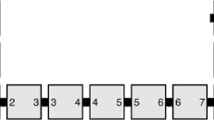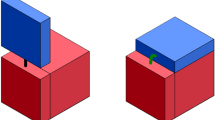Abstract
Many different constructions of proofreading tile sets have been proposed in the literature to reduce the effect of deviations from ideal behaviour of the dynamics of the molecular tile self-assembly process. In this paper, we consider the effect on the tile assembly process of a different kind of non-ideality, namely, imperfections in the tiles themselves. We assume a scenario in which some small proportion of the tiles in a tile set are “malformed”. We study, through simulations, the effect of such malformed tiles on the self-assembly process within the kinetic Tile Assembly Model (kTAM). Our simulation results show that some tile set constructions show greater error-resilience in the presence of malformed tiles than others. For example, the 2- and 3-way overlay compact proofreading tile sets of Reif et al. (DNA Computing 10, Lecture Notes in Computer Science, vol 3384. Springer, 2005) are able to handle malformed tiles quite well. On the other hand, the snaked proofreading tile set of Chen and Goel (DNA Computing 10, Lecture Notes in Computer Science, vol 3384. Springer, 2005) fails to form even moderately sized tile assemblies when malformed tiles are present. We show how the Chen–Goel construction may be modified to yield new snaked proofreading tile sets that are resilient not only to errors intrinsic to the assembly process, but also to errors caused by malformed tiles.









Similar content being viewed by others
Notes
Available online at http://www.dna.caltech.edu/Xgrow.
In this paper, we use the terms “aggregate” and “aggregation” to mean an assembly of tiles.
This was called “nucleation error” by Chen and Goel (2005).
References
Chen H, Goel A (2005) Error free self-assembly using error prone tiles. In: DNA computing 10, Lecture Notes in Computer Science, vol 3384. Springer, Berlin Heidelberg New York, pp 62–75
Fujibayashi K, Zhang DY, Winfree E, Murata S (2008) Error suppression mechanisms for dna tile self-assembly and their simulation. Nat Comput (online). doi:10.1007/s11047-008-9093-9
Meng Y (2009) Error-resilient tile sets for DNA self-assembly. MSc Thesis, Queen’s University, Kingston, ON
Reif JH, Sahu S, Yin P (2005) Compact error-resilient computational DNA tiling assemblies. In: DNA Computing 10, Lecture Notes in Computer Science, vol 3384. Springer, Berlin Heidelberg New York, pp 293–307
Rothemund PWK, Papadakis N, Winfree E (2004) Algorithmic self-assembly of DNA Sierpinski triangles. PLoS Biol 2:2041–2053
Soloveichik D, Winfree E (2006) Complexity of compact proofreading for self-assembled patterns. In: DNA Computing 11, Lecture Notes in Computer Science, vol 3892. Springer, Berlin Heidelberg New York, pp 305–324
Wang H (1961) Proving theorems by pattern recognition II. Bell Syst Tech J 40:1–42
Winfree E (1998a) Algorithmic self-assembly of DNA. PhD Dissertation, California Institute of Technology
Winfree E (1998b) Simulation of computing by self-assembly. Caltech CSTR: 1998.22. California Institute of Technology
Winfree E, Bekbolatov R (2004) Proofreading tile sets: error correction for algorithmic self-assembly. In: DNA Computing 9, Lecture Notes in Computer Science, vol 2943. Springer, Berlin Heidelberg New York, pp 126–144
Acknowledgements
This work was supported in part by a Discovery Grant from the Natural Sciences and Engineering Research Council (NSERC) of Canada. The final revision of this work was performed while the second author was on leave at the Electrical Communication Engineering Department of the Indian Institute of Science, Bangalore.
Author information
Authors and Affiliations
Corresponding author
Rights and permissions
About this article
Cite this article
Meng, Y., Kashyap, N. The effect of malformed tiles on tile assemblies within the kinetic tile assembly model. Nat Comput 10, 357–373 (2011). https://doi.org/10.1007/s11047-010-9234-9
Received:
Accepted:
Published:
Issue Date:
DOI: https://doi.org/10.1007/s11047-010-9234-9




